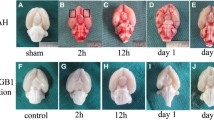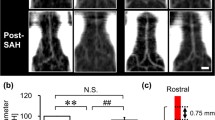ABSTRACT
Cardiac arrest (CA), if untreated for more than 5 min, can induce severe brain damage, the underlying mechanism of which is still unclear. Previous studies have indicated that high-mobility group box 1 (HMGB1), a nuclear protein implicated in several inflammatory disorders, is involved in the inflammatory processes following brain ischemia. However, the role of HMGB1 in brain dysfunction after CA is yet to be determined. In a rat CA model, HMGB1 protein expression was higher at 1, 3, and 7 days post-CA, compared to that in naïve and sham-treated rats. Following injection of HMGB1 antibody (anti-HMGB1) into the cerebral ventricles, neurological deficit scores were significantly decreased in the CA group as compared to that in the naïve and sham group. Nissl staining showed significant neuronal loss in the hippocampal CA1 region following CA, which was significantly attenuated by anti-HMGB1-treatment (10 and 50 μg) in comparison with the vehicle-injected control. CA induced a significant increase in the levels of the cytokine interleukin-1β (IL-1β) and tumor necrosis factor α (TNF-α) in the hippocampus as revealed by real-time polymerase chain reaction and enzyme-linked immunosorbent assay. Treatment with anti-HMGB1 significantly inhibited IL-1β and TNF-α expression. Our study suggests that HMGB1 contributes significantly to CA-induced brain dysfunction and that inhibiting HMGB1 function and expression may be an effective therapeutic approach to CA-induced ischemic brain injury.




Similar content being viewed by others
REFERENCES
Andersson, U., H. Erlandsson-Harris, H. Yang, and K.J. Tracey. 2002. HMGB1 as a DNA-binding cytokine. J Leukoc Biol. 72: 1084–1091.
Bottiger, B.W., B. Schmitz, C. Wiessner, P. Vogel, and K.A. Hossmann. 1998. Neuronal stress response and neuronal cell damage after cardiocirculatory arrest in rats. J Cereb Blood Flow Metab. 18: 1077–1087.
Boutin, H., R.A. LeFeuvre, R. Horai, M. Asano, Y. Iwakura, and N.J. Rothwell. 2001. Role of IL-1alpha and IL-1beta in ischemic brain damage. J Neurosci. 21: 5528–5534.
Chakraborty, S., D.K. Kaushik, M. Gupta, and A. Basu. 2010. Inflammasome signaling at the heart of central nervous system pathology. J Neurosci Res. 88: 1615–1631.
Ding, H.S., J. Yang, F.L. Gong, J. Yang, J.W. Ding, S. Li, and Y.R. Jiang. 2012. High mobility group box 1 mediates neutrophil recruitment in myocardial ischemia-reperfusion injury through toll like receptor 4-related pathway. Gene. 509: 149–153.
Eltzschig, H.K., and T. Eckle. 2011. Ischemia and reperfusion—from mechanism to translation. Nat Med. 17: 1391–1401.
Gao, C.J., L. Niu, P.C. Ren, W. Wang, C. Zhu, Y.Q. Li, W. Chai, and X.D. Sun. 2012. Hypoxic preconditioning attenuates global cerebral ischemic injury following asphyxial cardiac arrest through regulation of delta opioid receptor system. Neuroscience. 202: 352–362.
Kwon, W.Y., G.J. Suh, K.S. Kim, H.J. Lee, K.Y. Jeong, Y.H. Kwak, and K. Kim. 2013. Niacin suppresses the mitogen-activated protein kinase pathway and attenuates brain injury after cardiac arrest in rats. Crit Care Med. 41: e223–e232.
Lotze, M.T., and K.J. Tracey. 2005. High-mobility group box 1 protein (HMGB1): nuclear weapon in the immune arsenal. Nat Rev Immunol. 5: 331–342.
Mitola, S., M. Belleri, C. Urbinati, D. Coltrini, B. Sparatore, M. Pedrazzi, E. Melloni, and M. Presta. 2006. Cutting edge: extracellular high mobility group box-1 protein is a proangiogenic cytokine. J Immunol. 176: 12–15.
Morancho, A., A. Rosell, L. Garcia-Bonilla, and J. Montaner. 2010. Metalloproteinase and stroke infarct size: role for anti-inflammatory treatment. Ann N Y Acad Sci. 1207: 123–133.
Nichol, G., E. Thomas, C.W. Callaway, J. Hedges, J.L. Powell, T.P. Aufderheide, T. Rea, R. Lowe, T. Brown, J. Dreyer, D. Davis, A. Idris, and I. Stiell. 2008. Regional variation in out-of-hospital cardiac arrest incidence and outcome. JAMA. 300: 1423–1431.
Pedrazzi, M., M. Patrone, M. Passalacqua, E. Ranzato, D. Colamassaro, B. Sparatore, S. Pontremoli, and E. Melloni. 2007. Selective proinflammatory activation of astrocytes by high-mobility group box 1 protein signaling. J Immunol. 179: 8525–8532.
Qiu, J., J. Xu, Y. Zheng, Y. Wei, X. Zhu, E.H. Lo, M.A. Moskowitz, and J.R. Sims. 2010. High-mobility group box 1 promotes metalloproteinase-9 upregulation through Toll-like receptor 4 after cerebral ischemia. Stroke. 41: 2077–2082.
Shichita, T., R. Sakaguchi, M. Suzuki, and A. Yoshimura. 2012. Post-ischemic inflammation in the brain. Front Immunol. 3: 132.
Wang, Q., Q. Ding, Y. Zhou, X. Gou, L. Hou, S. Chen, Z. Zhu, and L. Xiong. 2009. Ethyl pyruvate attenuates spinal cord ischemic injury with a wide therapeutic window through inhibiting high-mobility group box 1 release in rabbits. Anesthesiology. 110: 1279–1286.
Wang, Y., Y. Li, L. Wang, Y. Kang, J. Zhang, Z. Liu, K. Wang, A. Kaye, and L. Chen. 2015. Tanshinone IIA attenuates chronic pancreatitis-induced pain in rats via downregulation of HMGB1 and TRL4 expression in the spinal cord. Pain Physician 18: E615–E628.
Yanai, H., T. Ban, and T. Taniguchi. 2012. High-mobility group box family of proteins: ligand and sensor for innate immunity. Trends Immunol. 33: 633–640.
Yanai, H., T. Ban, Z. Wang, M.K. Choi, T. Kawamura, H. Negishi, M. Nakasato, Y. Lu, S. Hangai, R. Koshiba, D. Savitsky, L. Ronfani, S. Akira, M.E. Bianchi, K. Honda, T. Tamura, T. Kodama, and T. Taniguchi. 2009. HMGB proteins function as universal sentinels for rnucleic-acid-mediated innate immune responses. Nature. 462: 99–103.
Zhang, J., H.K. Takahashi, K. Liu, H. Wake, R. Liu, T. Maruo, I. Date, T. Yoshino, A. Ohtsuka, S. Mori, and M. Nishibori. 2011. Anti-high mobility group box-1 monoclonal antibody protects the blood-brain barrier from ischemia-induced disruption in rats. Stroke. 42: 1420–1428.
ACKNOWLEDGMENTS
This work was supported by the Scientific Research Fund Project of Tianjin Health Bureau (303070100201), the Scientific Research Fund of Tianjin Medical University (3030502030070), and the National Key Clinical Specialty Project.
Author information
Authors and Affiliations
Corresponding authors
Ethics declarations
Conflict of Interest
The authors declare that there are no conflicts of interest.
Additional information
Mei Xu, Gui-ming Zhou and Li-hua Wang contributed equally to this work.
Rights and permissions
About this article
Cite this article
Xu, M., Zhou, Gm., Wang, Lh. et al. Inhibiting High-Mobility Group Box 1 (HMGB1) Attenuates Inflammatory Cytokine Expression and Neurological Deficit in Ischemic Brain Injury Following Cardiac Arrest in Rats. Inflammation 39, 1594–1602 (2016). https://doi.org/10.1007/s10753-016-0395-2
Published:
Issue Date:
DOI: https://doi.org/10.1007/s10753-016-0395-2




